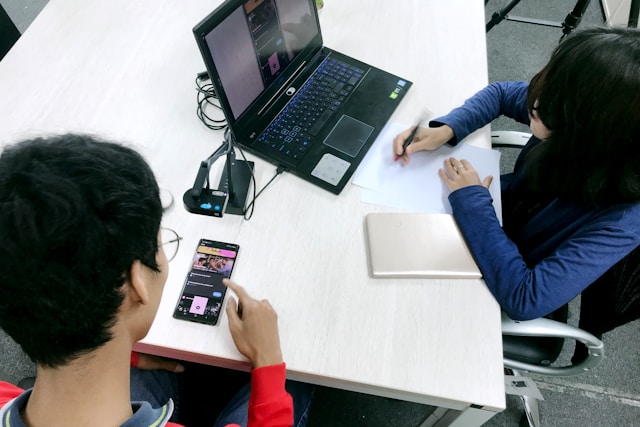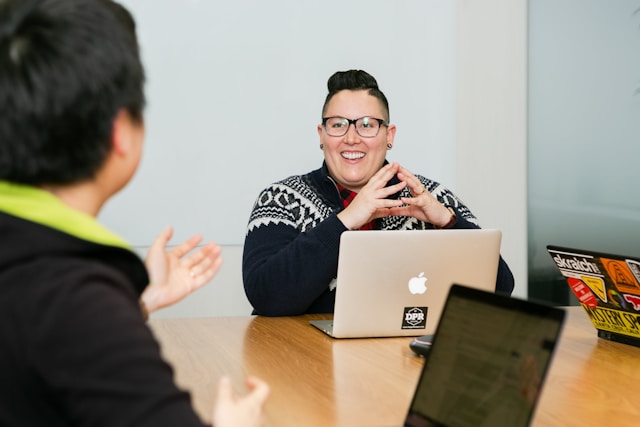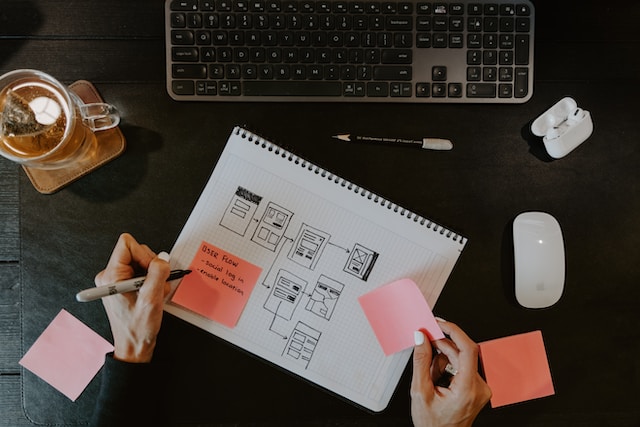In UX, nothing is more important than understanding your users. It’s the cornerstone of designing a user-centric product. However, you can’t understand your users without getting to know them. This is where user interviews come in.
User interviews are a powerful tool for diving into the minds of your target audience. They help you to empathize with real users and unearth the hidden gems that define seamless UX.
This guide will cover why interviews are great and how to conduct useful user interviews. Keep reading to learn more.

Why Are Interviews a Good UX Research Method?
User interviews are the perfect research method to help you gain in-depth insights. Of course, choosing the right UX research method is no easy feat. However, you should seriously consider incorporating interviews into your research plan.
When done correctly, interviews can help you learn:
- What your users’ pain points are
- If they have memorable experiences, and why they’re memorable
- How users think or feel about something
- What their mental models are
- What their motivations, goals, and desires are
- What they care about
This is all-important qualitative data that you can use to develop a great product. Of course, the data alone is usually of little help. You’ll need to collate what you learn during interviews. Then, you can use it to make:
- User personas
- Empathy maps
- Customer journey maps
Whatever you choose to do with your interviews, these can help you empathize with your users more.

How to Conduct User Interviews
Interviewing is a difficult skill to master. It requires knowing how to read the interviewee’s body language and which questions are the right ones to ask. Here’s a step-by-step guide on how to conduct user interviews.
1. Define Your Research
As with any research method, you first need to define the scope of the inquiry. If you want to produce actionable insights, you need to outline what you want to find out.
So, start by writing down your research goals. These need to be quite specific, such as:
- What makes users stop using our product?
- Why do customers consider our product?
- How much background knowledge of the product do new users have?
Once you have your goals, you can start to plan the interview in more detail.
2. Create a Guide
Next, you can devise a user interview guide. This document will guide you through the questions and help you answer your research questions. The guide should include some open-ended questions that get the interviewee to open up and start talking.
Often, these aren’t actually questions. They may be more like directives. For example, “Tell me about the last time you used this product and what you were doing.”
During this conversation, you can be more specific and try to jog their memory. This is also where interview skills come in because you need to listen actively. Ask follow-up questions throughout so that you can go more in-depth with their answers.
Remember, the interview guide isn’t a strict roadmap. Instead, it’s there to prompt you.
3. Test Your Guide
UX is iterative. As it turns out, so are UX interviews. You may find that you need to tweak your guide fairly early on in the process.
Try testing your guide before you do a real interview. You can try it with a friend or a colleague, or you can recruit a target user.
Doing this will help you learn if any of the questions are confusing. You might find that you need to add new questions or remove some of them. Or, you might want to change the order of the questions.
You can make tweaks to the guide again later down the line. However, you should try not to make too many changes, or you risk damaging the dataset.
4. Ease Into It
As you start interviewing, you’ll find that many participants are nervous at the start of each interview. It’s important to master the art of starting an interview.
Here are some tips:
- Start by introducing yourself and making some small talk. Try to put the interviewee at ease.
- Explain the purpose of the interview and briefly cover the types of questions you will ask. You should also tell the participant how you will use the information.
- Speak slowly and clearly, showing that you have time to listen.
- Start with the easiest questions that get your participant to open up.
- Avoid asking questions that are personal or judgmental.
5. Build Rapport
Your participants are more likely to give you useful information if they feel relaxed. So, throughout the interview, try to build a rapport with the participant. It’s not about you, so don’t try to befriend the interviewee. You don’t need to make jokes or pitch in with your ideas.
Instead, you can build a rapport by actively listening and asking questions. You can also use both verbal and non-verbal cues to show that you’re listening. This includes your body language, with eye contact and nodding. You can also acknowledge their answers or echo what they’ve said.
Crucially, you should avoid interrupting or rushing your participants.
6. Follow Up
Don’t be afraid to go deeper by asking follow-up questions throughout the interview. These questions often uncover the things you really want to know.
It’s a good idea to have some key phrases under your belt that will help you. This includes:
- Tell me more about that.
- What do you think/feel about that?
- Why is that important to you?
- Can you expand on that?
The more you interview, the better you’ll get at seeing where these fit into your conversations.

The Best User Interview Questions
There is no singular list of user interview questions because every research project is different. However, there are some questions that might inspire your interview guide. That said, the questions vary depending on your research goals and where you’re at in the design process.
For example, if you’re testing out a new concept, you might ask the following.
- What’s your first reaction to this prototype?
- How would you improve this design?
- Who do you think is the target audience for this?
- What do you like and dislike about this prototype?
Meanwhile, if you already have a product, the questions could look totally different. Let’s say you’re trying to improve an existing product. You could ask these questions:
- What do you like and dislike about this product?
- How do you feel this product compares with [competitor’s product]?
- How likely are you to continue using this product?
- What would prevent you from using this product?
- Does this product have everything you need to complete X task?
However, if you’re simply measuring user satisfaction following the launch, you might ask:
- Can you tell me about your experience with our product?
- How does our product compare to the service you receive from other brands?
- How likely are you to recommend us to a friend or colleague?
It’s important to ask questions specific to your research goal. That way, you can get to the bottom of your questions.
Regular Interview vs. Contextual Interview
You might also have heard of a contextual interview. These are another great tool for learning valuable insights about your user base. However, they differ from regular interviews in several ways.
A typical interview involves a structured set of questions posed to users in a controlled environment. While this is useful for learning about your target audience, it risks missing the nuances of real-world experiences.
This is where contextual interviews come in. They take place within the users’ natural environment, such as their workplace. As a result, they uncover unique aspects of the users’ daily lives.
Contextual interviews emphasize observing users in action. The interviewer can, therefore, gain firsthand knowledge of their behaviors, challenges, and decision-making processes. With the right skills, the interviewer can uncover insights that might have remained hidden in a normal interview.
That said, contextual interviews aren’t always the right choice. During the prototyping phase, for example, you can’t use contextual interviews. As a UX researcher, it’s your job to figure out which method is best for which research question.

Interviewing During User Experience Testing
Conducting interviews during user experience testing can add a layer of depth to your data. They can give you a comprehensive understanding of user interactions and perceptions.
The best way to do this is usually to incorporate think-aloud protocols into the test. This means that while users complete the task, they narrate their thoughts out loud. The observing interviewer can gain real-time insights into the user’s decisions.
You can also use post-task interviews. When the user completes the task, they then undergo a traditional interview. This asks questions that the interviewer wants to know more about. For example:
- How easy was it to complete this task?
- Why did you take the X approach?
- Did you find all the information you needed?
- What would have made it easier to complete the task?
Generally, open-ended questions work better because the user is more likely to share their feelings.
Interviewing during user tests means that you can gather both quantitative and qualitative data at the same time. It’s a great way to humanize your quantitative data and add a new dimension to it. As a result, you can learn more about potential usability issues.
Are There Other Kinds of Qualitative Research?
Interviewing is a qualitative research method. There are several other qualitative methods you can use, including:
- Usability testing via observation
- Card sorting, which involves sorting information into categories
- Focus groups, which facilitate discussions to uncover collective perceptions
- Surveys, which provide written responses without an interviewer present
You can use these either alone or in conjunction with interviews. Again, it’s up to the UX researcher to determine which method is best. Remember, the method should work for the research question at hand.
Typically, it’s a good idea to collect both quantitative and qualitative data during user testing. This way, you have numerical data to inform your design decisions and human data to empathize with your users.

Go Beyond Interviews With Page Flows
User research is just one step of the design process. Conducting user interviews properly can take you a little closer to designing a fantastic product. Interviews can help you understand your users, their problems, and their goals. Thus, you can start to ideate about potential solutions.
After that, you’re going to need some inspiration for your designs. If you’re looking for top-tier design inspiration, why not learn from proven products? Page Flows is a helpful resource for finding interaction design ideas. Get started today to access our growing library of user flow recordings and finally stay up-to-date with current design trends.





